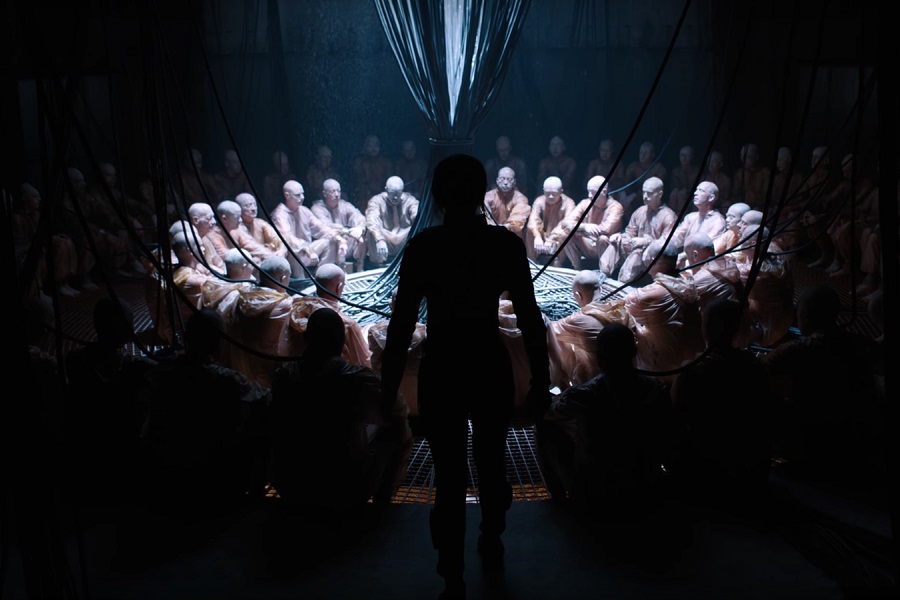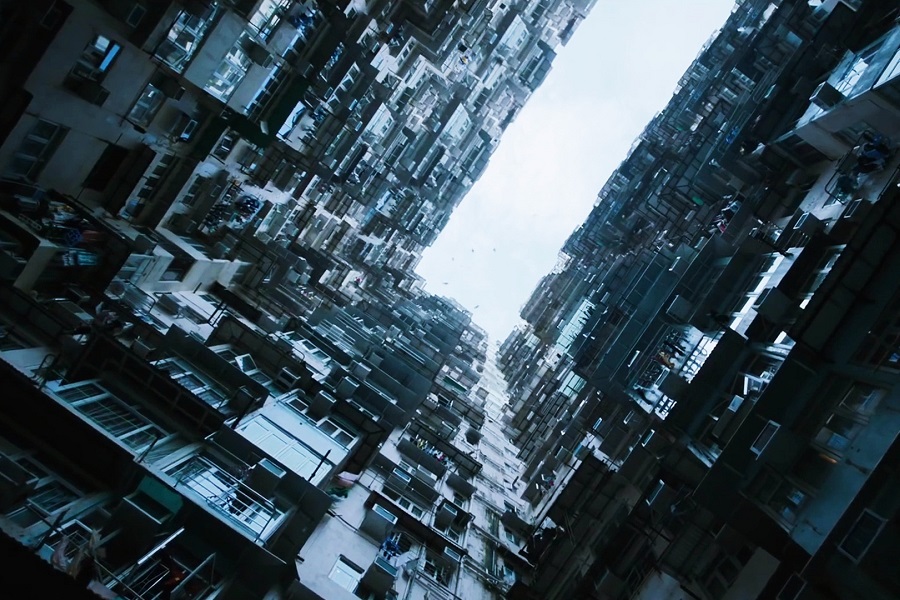Combining technology, action and a healthy dose of philosophy, Ghost in the Shell would seem to be easiest of manga properties to make the transition to live action. Sadly, it just misses the mark, turning in a visually sumptuous but soulless affair. While never outright bad, it plods along at an strangely boring pace. Time also hasn’t been kind, with countless other movies and tv programs weaving elements that initially served as inspiration, into their own DNA.
Major Mira Killian (Scarlett Johansson) is the latest brilliant creation of Hanka Robotics. A state of the art cybernetic body with a human brain, or “ghost”. She is seen by some as the pinnacle of evolution. Unsure of where she is, or what is happening, she is soothed by Dr. Ouelet (Juliette Binoche). A surrogate mother of sorts, Ouelet assures the Major that she is just as human as she is machine, even if she may not believe so. After a year adapting to her situation, she becomes a hardened operative of Section 9, a secretive organization, tasked with fighting cyber crime and acts of terror. A never-ending task, seeing as how, in this future, roughly 73% of the human population has some form of “enhancement”. After a terrorist named Kuze (Michael Pitt) starts to kill off top members of Hanke, the organization is called in to investigate as the Major begins to content with ever present “glitches”, which may be connected to the case.
The prospect of making a feature-length, big budget tentpole film like Ghost in the Shell would be a dream for any established director, let alone one hoping to make their mark. Unfortunately for everyone involved, the studio saw fit to hire Rupert Sanders, he of Snow White and the Huntsman fame (or infamy). Sanders clearly has an eye for flair, but when it comes to telling a story, or coercing stirring performances, he is found lacking. Another factor may be a story that is “basic”, to say the least.
 Scarlett Johnasson plays Major with a certain detachment that seems to switch from scene to scene. More often than not she plays things 2-3 shades cooler than the rest of her counterparts. Her steely resolve is serviceable at times, even occasionally organic to the work. More often than not, it comes off as slightly “too” robotic. That my be an issue of the script, which makes sure to have at least one person telling Major “you are still a human, you have a human brain and soul”, in each scene. The other likelihood is that Johansson is lowering herself to the level of work itself. Recent efforts, like Lucy and Under the Skin, or even the voice work of Her, have shown that she is among the best working actresses. If not at least, the hardest working one.
Scarlett Johnasson plays Major with a certain detachment that seems to switch from scene to scene. More often than not she plays things 2-3 shades cooler than the rest of her counterparts. Her steely resolve is serviceable at times, even occasionally organic to the work. More often than not, it comes off as slightly “too” robotic. That my be an issue of the script, which makes sure to have at least one person telling Major “you are still a human, you have a human brain and soul”, in each scene. The other likelihood is that Johansson is lowering herself to the level of work itself. Recent efforts, like Lucy and Under the Skin, or even the voice work of Her, have shown that she is among the best working actresses. If not at least, the hardest working one.
Though Johansson seems all over the place, the bulk of the team for Section 9 is simply utterly forgettable. While admittedly decently diverse they are little more than blank slates. Thankfully there is some humanity to make up for it in Batou (Pilou Asbaek). Quite a bit actually, as the squad essentially chastises him for being one of the few members of the squad that’s largely human (save for a mind communication device). Then again this is a group which features an individual who switched out his liver so he can’t get drunk and is then never seen with a drink in his hand. Batou, in his own stoic way, ends up saving the film, by injecting both pathos and levity at just the right moment. His relationship with the Major feels lived in, or the closest approximation of real thst this world can get to. These aren’t romantic feelings either, but of a partner, deeply invested in a close compatriot.
Not to be outdone by the “new guard”, Ghost in the Shell also features 2 small, yet stellar supporting roles. Proving that a bit of effort and slight more screen time (compared to 2014’s Godzilla) can go a long way, Binoche does wonders as the conflicted Ouelet. She understands the ramifications of playing god and the dangers in caring for something that isn’t hers to cry over. A thankless role indeed, yet one salvaged by a hint of gravitas. The other slot belongs to Takeshi Kitano, that old stalwart of Japanese cinema. Merely by being in the room, Kitano brings an understated coolness to the chief of Section 9, Aramaki. Even if 80% of those scenes simply involve him sitting at his desk, on a bench, or at the edge of his bed. Because Kitano is synonymous with action, it should come as no surprise that he get the best beat of all. Better yet, it is quick, simple and lean. A lesson the rest of the movie could stand to replicate.
One of the biggest hurtles this version of Ghost in the Shell fails to tackle is whether or not it genuinely cares about the bigger issues it has on its mind . The desire to scrape past the surface of the existential dread pertaining to “what does it mean to be human?” (outside of plainly asking it, of course) doesn’t seem to exist. Pontification can be all fine and good, but only in service of putting forth at least some ideals. Doing so often naturally leads to a form of discussion, or at least argument between characters. If they merely stare silently at one another in introspection that never produces any results or growth, well then, that there is just shoddy craftsmanship.

At 105 minutes, Ghost In The Shell is overstuffed with ideas and characters to the point that it becomes a jumbled mess. Scenes feel rushed, in order to get to the next action sequence or city shot. Instances that usually need room to breath, focusing on soul searching and general conversation get pushed aside for another sweeping vista (or product placement hiding in the corner of the screen). Adding to this disconnect is the fact that the movie has elected to eschew the practice of openly adapting the source material. While still done to a degree, the team of Jamie Moss, William Wheeler and Ehren Kruger instead decide to cherry pick from every iteration that has existed. To the general audience this won’t seem like much of a bother, as the patchwork quilt of a plot makes enough sense to manage by. It’s as though the writers weren’t sure what to do with the plot points they did snatch up, as mystery and exploration give way to a boring corporate conspiracy. For those who are familiar with the franchise, Ghost in the Shell plays like a greatest hits album, but assembled by a bad cover band. They can dress the part and may know all the words, but everything else feels vacant and amateurish.
Something like this seeps its way into every aspect of the film, even the ostensible villain. When an actor like Micheal Pitt is cast in a film, there is an unspoken expectation that his performance will be a highlight, even if due to the wrong reasons. He typically commands a screen with the same intensity that’s usually reserved for Nicholas Cage or Michael Shannon. Here, he is undone by visual design and post-processed vocal tics. Any humanity that ekes out, is by sheer quiet force of will. As Kuze, Pitt paints a picture of a character much like the Great and Powerful Oz. Under shroud and rarely seen, he strikes at an establishment that wronged him for reasons he isn’t entirely sure of. Unmasked though, his lightly existential questioning rings hollow. At the same time, when this occurs, the story begins to show that it’s pivoting things in service of a much less interesting, more common outcome.
The visual aesthetic owes as much to the original source material as it does the entire history of science fiction movies. Pieces of Metropolis, Blade Runner, The Fifth Element and even Zero Theorem make up the thriving cityscape. Though, unfortunately 3rd act elements call Johnny Mnemonic and Ultraviolet to mind. Even if it owes more than a little to the past, there is no denying that it is the highlight of the film. If ever there was movie that demanded the highest quality home theater system, just to watch with the isolated score enabled, this was it. Weta and production designer Jan Roelfs and cinematographer Jess Hall do next level work that belongs in a more interesting, or at least more engaging, picture.
The elephant in the room when merely mentioning 2017’s Ghost in the Shell, is the much discussed aspect of whitewashing, and while it won’t be directly covered here, the movie does point it out. Although the manner of which it goes about doing so makes things more problematic than they initially were. In the mind of the filmmakers, they seem to think the act is daring. It speaks to the wrongheadedness of the whole situation. No one should have to bend over backwards to explain why the previously mentioned elephant appears to be dressed up like a tiger*.

Ghost in the Shell never is quite sure of what it wants to say or do, outside of mildly entertain. In that facet, it succeeds. Minor victories and what not. The visual aspect drives the movie apart from the rest of the pack, with action peppered throughout to cover up a lackluster script that is beholden to all possible source material, instead of choosing one launching off point. At the very least what’s on display is emblematic of the current blockbuster spell, beautiful movies devoid of soul or originality. In a better world, a film like this would answer the questions it posses in a strong fashion or at least in way that starts discussion. The only talks Ghost in the Shell is likely to start, are those concerning how problematic the film is. That’s something no amount of pretty images can cover up.
*The movie’s analogy, more or less, not mine.



